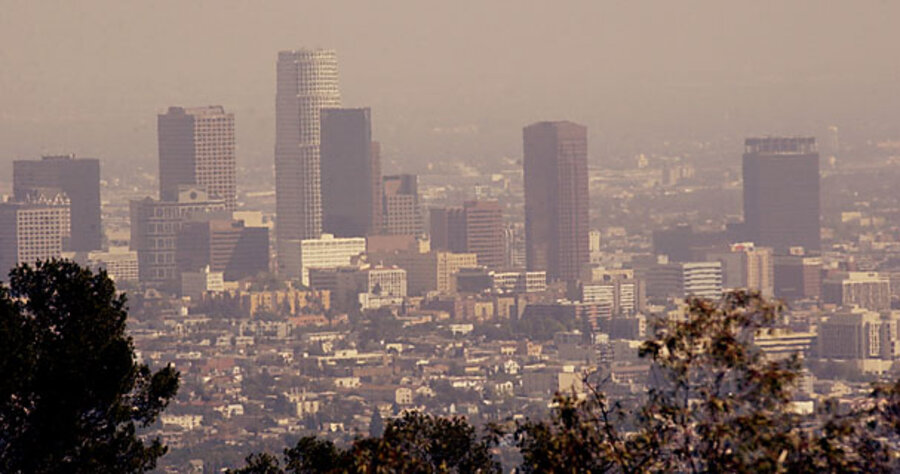California’s plan to cut emissions heavy on mandates
Loading...
| Oakland, Calif.
In the most ambitious effort yet in the US to reduce greenhouse gases, California will mandate dramatic increases in automobile efficiency, cleaner fuels, and renewable power.
The state’s Air Resources Board released a regulation-heavy draft plan Thursday to help implement the landmark Global Warming Solutions Act of 2006. The law, the first of its kind in the US, commits the state to cutting 30 percent of its greenhouse-gas emissions by 2020.
Most emission cuts will be accomplished through government regulations. The remaining 20 percent is left up to industry through a new emissions trading system involving seven Western states and some Canadian provinces.
That ratio pleases some environmentalists and analysts, but disappoints key industries hoping for greater flexibility. The plan touches nearly every aspect of California’s $1.7 trillion economy and is likely to spur large new industries as well as raise fuel and energy costs.
“It’s a balance of big regulation and ambitious market scheme. I think it’s an impressive first effort at a greenhouse-gas plan for the state,” says Charles Kolstad, professor of environmental economics at the University of California, Santa Barbara.
Distrust of market-based mechanisms in California means that the plan had to involve direct regulations, he says.
The ARB chair, Mary Nichols, described the plan as “comprehensive,” and said California’s example will help “motivate other states and our nation to enter into lasting plans to address this problem.”
The largest cuts will come from:
• Transportation: The state renews its fight for autos that emit 30 percent less greenhouse gas. The effort has been blocked at the federal level, but California expects support from the next administration. Refineries must also produce lower-carbon gasoline and diesel.
• Utilities: A third of California’s electricity must come from renewable sources such as solar and wind power. As of 2006, that figure stood at 10.9 percent.
• Energy efficiency: The state will set tougher appliance efficiency standards, green building codes, and water conservation measures.
Regulation will do most of the work in bringing the main sources of greenhouse gases within the state’s new emissions cap. The shortfall will be handled through a cap-and-trade system.
These market-based schemes force polluters to acquire credits for their level of emissions. Government sets a cap on these credits, racheting it down over time. Polluters can buy and sell credits, creating a financial incentive to adopt cleaner technologies.
The system will be developed jointly with a regional coalition known as the Western Climate Initiative. Some initial emission credits are likely to be sold, not given, to polluters. And ARB plans to limit the use of offsets, a way to “reduce” emissions by funding green projects.
It’s unclear what the costs of implementing the plan will be. The ARB will release details later, but claims it will bring an added 1 percent gross domestic product by 2020. California soaked up $1 billion of clean technology investment in 2006, they note.
But others point out the impact of higher fuel prices and job losses in the regulated industries. “I’m skeptical about an end result of economic gains,” says Dr. Kolstad, adding that how the plan affects “average Californians in their pocketbook” will be “the barometer of acceptance of it.”
Some early criticism came from industry groups. “It’s the largest regulatory program I have ever been involved in in 15 years,” says Cathy Reheis-Boyd, chief operating officer for the Western States Petroleum Association. She emphasizes that her industry supports the reduction goals but says cap-and-trade is the cheapest way to get there.
She had other concerns, too. There’s no price ceiling to protect against unforeseen price spikes on the carbon exchange. And the fuel regulations leave refineries nonplussed over how to meet their carbon reductions before someone invents a better biofuel.
Others echoed a preference for less regulation. “If the plan says that only 20 percent of the reductions will be secured through a market, then you better [hope] the government is four times more likely to come up with reductions,” says Josh Margolis, joint CEO of CantorCO2e, a financial services company focused on energy and environment.
But Dan Kammen, an energy expert with the University of California working with the government, argues that many of the regulations build on well-organized programs, helping reduce the unknowns in this new system. “For us to count on cap-and-trade to do the bulk of the work, never having done this system here, would be a little risky,” says Dr. Kammen. He points out that cap-and-trade will affect some sectors more than others; regulations help spread burdens.
He suspects cap-and-trade will prove more effective at cutting emissions than the plan outlines. If so, some of the regulatory time lines could be relaxed, he says.
Over the summer, the ARB will take comments and make revisions before approving a plan in November. Then it will be implemented through government rule making – a process the ARB believes it has wide authority over.
“It’s a strong, independent board, and they are really the last say, except the law does allow the governor to delay any of the rules for a year,” says Bill Magavern, director of Sierra Club, California. He applauds the ARB’s proposal, calling it “balanced” and “comprehensive.”






